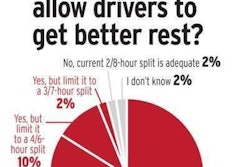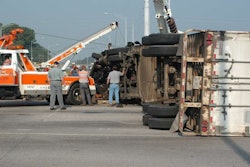I had a conversation earlier this week with a defense attorney who works cases for trucking-company insurers and truckers themselves. Rob Moseley, based in Greeneville, S.C., with the Smith Moore Leatherwood firm, remarked on the truck-involved crash fatality rate and its decline in 2014 — likewise the attendant, countervailing spike in the volume of injuries.
Though Moseley wasn’t looking at the stats while we spoke, and there’s “nothing scientific about my conclusion,” he said, it all signaled to him that “we’ve got more crashes but less serious crashes – we’re doing better at mitigating against the serious crash, but those that we’re having are involving injuries.”
Here’s how the total fatality numbers have looked since 1995 for large combination trucks:
Over the long term, not only is the fatality rate (fatalities figured per vehicle miles traveled) down, but so is the simple volume of highway deaths in crashes involving combination trucks. It’s a well-known fact, and attributable to a confluence of factors (including industry safety writ broadly) I won’t go into here. Moseley had more to say with his speculation that brought to mind reporting from years past on the year-to-year fluctuations in the number of truck occupant fatalities in truck-involved crashes. “An awful lot of the fatalities involving commercial trucks are one-vehicle accidents,” Moseley noted. The decline in the fatality rate he speculated could be seen as a “good sign we have fewer drivers going off the road and getting killed.”
It could even be a reflection of the 34-hour restart in the hours of service rules, he noted — in 2014, the two 1-5 a.m. periods, you’ll remember, were required to be used in any restart. Perhaps more drivers were getting better sleep and fewer were running off the road and getting killed in a single-vehicle crash? (Apply similar logic to the rise in injuries in 2014 and you might attribute it to more truckers being forced into rush hour around the nation by the 1-5 a.m. restart requirement, an argument that was part of the reasoning behind the suspension of those restart changes at the end of that year.)
While the combination-truck-occupant death statistics shown below aren’t limited to those that were single-vehicle crashes, they at least show that in terms of total numbers, 2014 stats don’t show an appreciable difference from the year prior, though aggregate numbers do show a downward trend in occupant deaths over the long term.
But Moseley postulated a guess about drivers’ own fatalities as it relates to the whole of truck-involved crash fatalities — extrapolating from that, I wondered about just what the volume of driver deaths among the total combination truck-involved fatality numbers might show. Has the share in fact fallen over the years as a share of total fatalities? Turns out that, viewed as a percentage of total fatalities, the trend for truck-occupant deaths looks a good deal different than the positive, declining trends among fatalities themselves.
With the exception of the doldrums of the recession in 2009-’10 calendar years, the trend over the last decades is up. Viewed this way, one conclusion could be that truck occupants/drivers aren’t benefiting from the safety improvements on the highways at the same rate as the entire population, at least when it comes to the most serious of highway accidents.
Put another way, truckers are doing an increasingly good job worrying about those they share the road with, but maybe not so much when it comes to their own.
But note just when the upward trend seems to begin its acceleration — year 2003 saw the share of truck-occupant deaths spike to 13.79 percent, and two years later that percentage would cross 14 percent for the first time in this 20-year span. It would spike again above 15 percent in 2007 and 16 percent in 2012. In 2014, the last year for which complete statistics are available, truck occupant deaths accounted for just under 16 percent of all fatalities in truck-involved (not responsible, keep in mind) crashes.
2003 was the year FMCSA published the final rule that began the hours of service era we’ve been in since that time — marked, as you know, by a rigid daily 14-hour on-duty limitation and very little flexibility in splitting the 10-hour daily required sleeper berth period. Over that same period, increasing fleet use of electronic logs has been the rule, giving that 14-hour window a little more teeth, so to speak.
In the view of many Overdrive readers, it all amounts to a growing dis-incentivize for drivers to take mid-duty-day rest.
Might that have something to do with the upward trend shown above?
With Congress and industry lobbyists hard at work in recent times toying with the hours of service as we know it, and FMCSA granting exemptions related to splitting the sleeper berth, greater sleeper-berth split flexibility might well be an item for reps to consider.
As offered by a reader recently, here’s that Capitol switchboard number again: 202-224-3121.











